lock MAZDA MODEL CX-50 2023 User Guide
[x] Cancel search | Manufacturer: MAZDA, Model Year: 2023, Model line: MODEL CX-50, Model: MAZDA MODEL CX-50 2023Pages: 583, PDF Size: 85.63 MB
Page 39 of 583
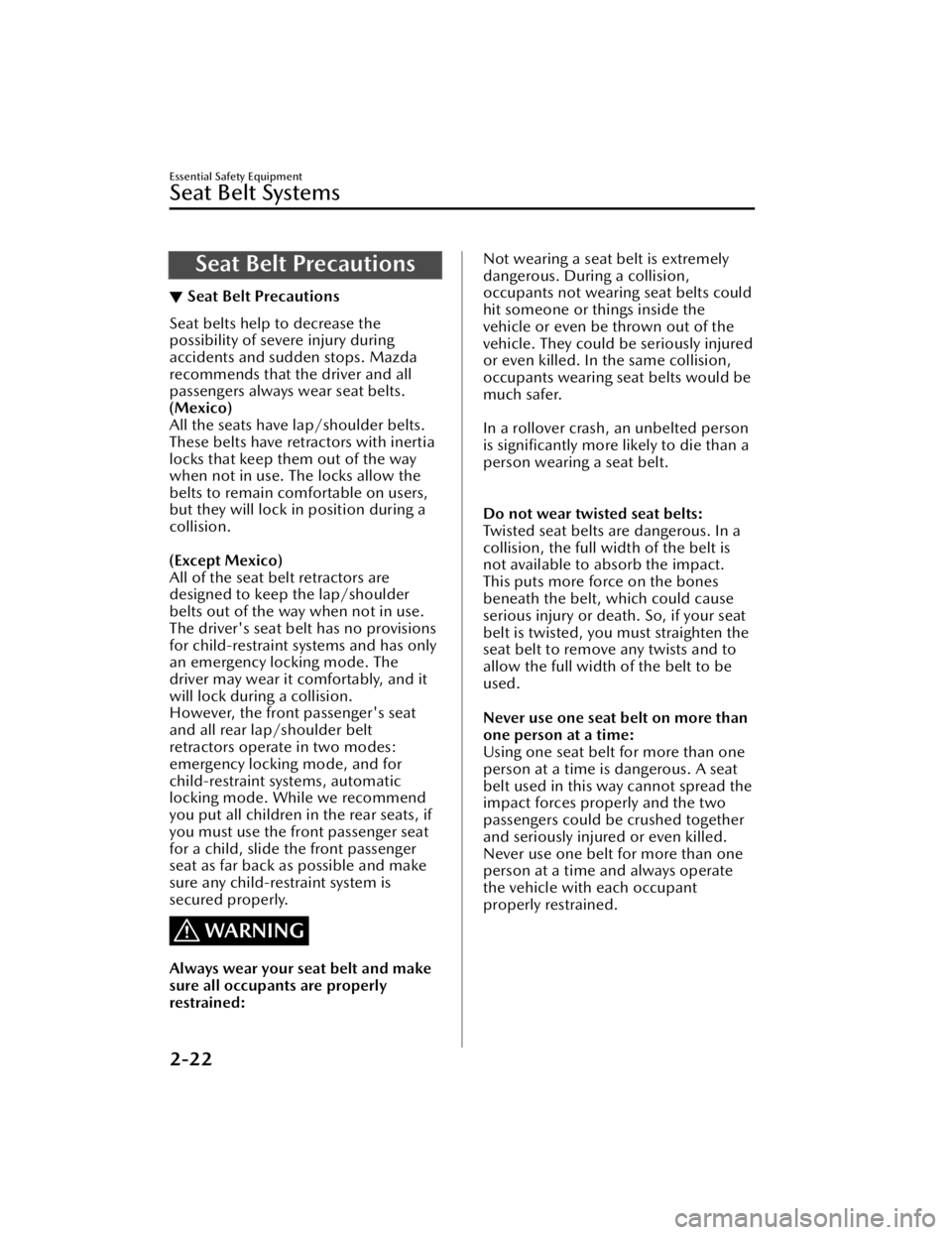
Seat Belt Precautions
▼Seat Belt Precautions
Seat belts help to decrease the
possibility of severe injury during
accidents and sudden stops. Mazda
recommends that the driver and all
passengers always wear seat belts.
(Mexico)
All the seats have lap/shoulder belts.
These belts have retractors with inertia
locks that keep them out of the way
when not in use. The locks allow the
belts to remain comfortable on users,
but they will lock in position during a
collision.
(Except Mexico)
All of the seat belt retractors are
designed to keep the lap/shoulder
belts out of the way when not in use.
The driver's seat belt has no provisions
for child-restraint systems and has only
an emergency locking mode. The
driver may wear it comfortably, and it
will lock during a collision.
However, the front passenger's seat
and all rear lap/shoulder belt
retractors operate in two modes:
emergency locking mode, and for
child-restraint systems, automatic
locking mode. While we recommend
you put all children in the rear seats, if
you must use the front passenger seat
for a child, slide the front passenger
seat as far back as possible and make
sure any child-restraint system is
secured properly.
WARNING
Always wear your seat belt and make
sure all occupants are properly
restrained:
Not wearing a seat belt is extremely
dangerous. During a collision,
occupants not wearing seat belts could
hit someone or things inside the
vehicle or even be thrown out of the
vehicle. They could be seriously injured
or even killed. In the same collision,
occupants wearing seat belts would be
much safer.
In a rollover crash, an unbelted person
is significantly more likely to die than a
person wearing a seat belt.
Do not wear twisted seat belts:
Twisted seat belts are dangerous. In a
collision, the full width of the belt is
not available to absorb the impact.
This puts more force on the bones
beneath the belt, which could cause
serious injury or death. So, if your seat
belt is twisted, you must straighten the
seat belt to remove any twists and to
allow the full width of the belt to be
used.
Never use one seat belt on more than
one person at a time:
Using one seat belt for more than one
person at a time is dangerous. A seat
belt used in this way cannot spread the
impact forces properly and the two
passengers could be crushed together
and seriously injured or even killed.
Never use one belt for more than one
person at a time and always operate
the vehicle with each occupant
properly restrained.
Essential Safety Equipment
Seat Belt Systems
2-22
CX-50_8KB8-EA-22A_Edition2_new
2022-1-6 14:55:18
Page 41 of 583
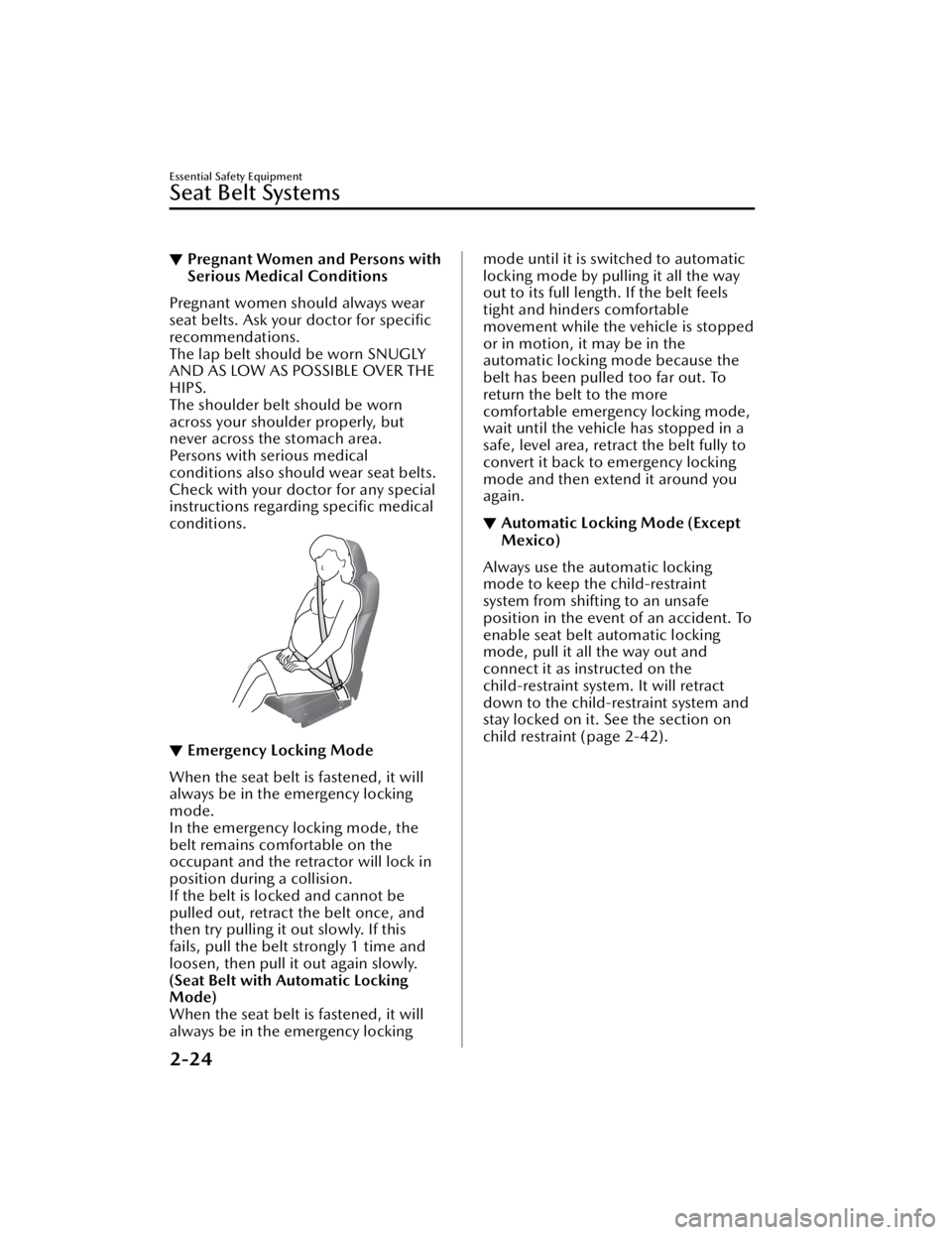
▼Pregnant Women and Persons with
Serious Medical Conditions
Pregnant women should always wear
seat belts. Ask your doctor for
specific
recommendations.
The lap belt should be worn SNUGLY
AND AS LOW AS POSSIBLE OVER THE
HIPS.
The shoulder belt should be worn
across your shoulder properly, but
never across the stomach area.
Persons with serious medical
conditions also should wear seat belts.
Check with your doctor for any special
instructions regarding specific medical
conditions.
▼ Emergency Locking Mode
When the seat belt is fastened, it will
always be in the emergency locking
mode.
In the emergency locking mode, the
belt remains comfortable on the
occupant and the retractor will lock in
position during a collision.
If the belt is locked and cannot be
pulled out, retract the belt once, and
then try pulling it out slowly. If this
fails, pull the belt strongly 1 time and
loosen, then pull it out again slowly.
(Seat Belt with Automatic Locking
Mode)
When the seat belt is fastened, it will
always be in the emergency locking
mode until it is switched to automatic
locking mode by pulling it all the way
out to its full length. If the belt feels
tight and hinders comfortable
movement while the vehicle is stopped
or in motion, it may be in the
automatic locking mode because the
belt has been pulled too far out. To
return the belt to the more
comfortable emergency locking mode,
wait until the vehicle has stopped in a
safe, level area, retract the belt fully to
convert it back to emergency locking
mode and then extend it around you
again.
▼ Automatic Locking Mode (Except
Mexico)
Always use the automatic locking
mode to keep the child-restraint
system from shifting to an unsafe
position in the event of an accident. To
enable seat belt automatic locking
mode, pull it all the way out and
connect it as instructed on the
child-restraint system. It will retract
down to the child-restraint system and
stay locked on it. See the section on
child restraint (page 2-42).
Essential Safety Equipment
Seat Belt Systems
2-24
CX-50_8KB8-EA-22A_Edition2_new
2022-1-6 14:55:18
Page 43 of 583

▼Front Shoulder Belt Adjuster
The front seat belts have a front
shoulder belt adjuster. If the seat belt
contacts your neck or it slips off the
shoulder, adjust the seat belt height.
To ra i s e
To heighten the seat belt, move the
front shoulder belt adjuster upward.
To l o w e r
To lower the seat belt, hold the front
shoulder belt adjuster and lower the
seat belt with the knob of the front
shoulder belt adjuster pressed.
After adjusting , press the front
shoulder belt adjuster downward and
make sure that it is securely locked.
Seat Belt Warning
Systems
▼Seat Belt Warning Systems
If it detects that the occupant seat belt
is unfastened, the warning light or
beep alerts the occupant.
Refer to Seat Belt Warning Indication/
Warning Light (Front seat) on page
7-28.
Refer to Seat Belt Warning Light (Rear
seat) (Red) on page 7-29.
Refer to Seat Belt Warning Beep on
page 7-36.
Seat belt indicator light (rear seat)
(green)
The light turns on when the rear seat
belt is fastened while the ignition is
switched ON, and it turns off after a
certain period.
Essential Safety Equipment
Seat Belt Systems
2-26
CX-50_8KB8-EA-22A_Edition2_new
2022-1-6 14:55:18
Page 51 of 583

Luggage or other items are placed on
the seat with the child in the
child-restraint system.
A rear passenger or luggage pushing
or pulling down on the front
passenger seatback.
Luggage or other items are placed on
the seatback or hung on the head
restraint.
The seat is washed.
Liquids are spilled on the seat.
The front passenger seat is moved
backward, pushing into luggage or
other items placed behind it.
The front passenger seatback
contacts the rear seat.
Luggage or other items are placed
between the front passenger seat
and driver seat.
An electric device is put on the front
passenger's seat.
An additional electrical device, such
as a seat warmer is installed to the
surface of the front passenger seat.
Any accessories, which might
increase the total seated weight on
the front passenger seat, are
attached to the front passenger seat.
The designated positions with seat
belts on the rear seats are the safest
places for children. Always use seat
belts and child restraints.
Do not allow a child or anyone to
lean over to or against the side
window of a vehicle with side and
curtain air bags:It is dangerous to allow anyone to lean
over to or against the side window, the
area of the front passenger seat, the
front and rear window pillars and the
roof edge along both sides from which
the side and curtain air bags deploy,
even if a child-restraint system is used.
The impact of inflation from a side or
curtain air bag could cause serious
injury or death to an out of position
child. Furthermore, leaning over to or
against the door could block the side
and curtain air bags and eliminate the
advantages of supplemental
protection. Because the front seats are
equipped with front air bags, the rear
seat is always a better location for
children. Take special care not to allow
a child to lean over to or against the
side window, even if the child is seated
in a child-restraint system.
Never use one seat belt on more than
one person at a time:
Using one seat belt for more than one
person at a time is dangerous. A seat
belt used in this way cannot spread the
impact forces properly and the two
passengers could be crushed together
and seriously injured or even killed.
Never use one belt for more than one
person at a time and always operate
the vehicle with each occupant
properly restrained.
CAUTION
A seat belt or child-restraint system can
become very hot in a closed vehicle
during warm weather. To avoid burning
yourself or a child, check them before
you or your child touches them.
Essential Safety Equipment
Child Restraint
2-34
CX-50_8KB8-EA-22A_Edition2_new 2022-1-6 14:55:18
Page 59 of 583

WARNING
Always attach the tether strap to the
correct tether anchor position:
Attaching the tether strap to the
incorrect tether anchor position is
dangerous. In a collision, the tether
strap could come off and loosen the
child-restraint system. If the
child-restraint system moves it could
result in death or injury to the child.
Always remove the head restraint and
install child-restraint system (except
when installing a backless booster
seat):
Installing a child-restraint system
without removing the head restraint is
dangerous. The child-restraint system
cannot be installed correctly which
may result in death or injury to the
child in a collision.
(Except Mexico)
1. Tether strap
2. Anchor bracket
3. Forward
Always install the head restraint and
adjust it to the appropriate position
after removing the child-restraint
system:
Driving with the head restraint
removed is dangerous as impact to the
occupant's head cannot be prevented
during emergency braking or in a
collision, which could result in a
serious accident, injury or death.
Refer to Head Restraints on page 2-15.
▼Using Automatic Locking Mode
(Except Mexico)
Follow these instructions when using a
child-restraint system, unless you are
attaching a LATCH-equipped
child-restraint system to the rear
LATCH lower anchors. Refer to “Using
LATCH Lower Anchor” (page 2-47).
NOTE
Follow the child-restraint system
manufacturer's instructions carefully. If
you are not sure whether you have a
LATCH system or tether, check in the
child-restraint system manufacturer's
instructions and follow them
accordingly. Depending on the type of
child-restraint system, it may use
LATCH system instead of seat belts or if
the belt goes across the child's chest,
may recommend against using
automatic locking mode.
1. Make sure the seatback is securely
latched by pushing it back until it is
fully locked.
2. Remove the head restraint. However, when installing a backless
booster seat, always install the
vehicle head restraint to the seat
where the backless booster seat is
installed.
Refer to Head Restraints on page
2-15.
Essential Safety Equipment
Child Restraint
2-42
CX-50_8KB8-EA-22A_Edition2_new 2022-1-6 14:55:18
Page 60 of 583
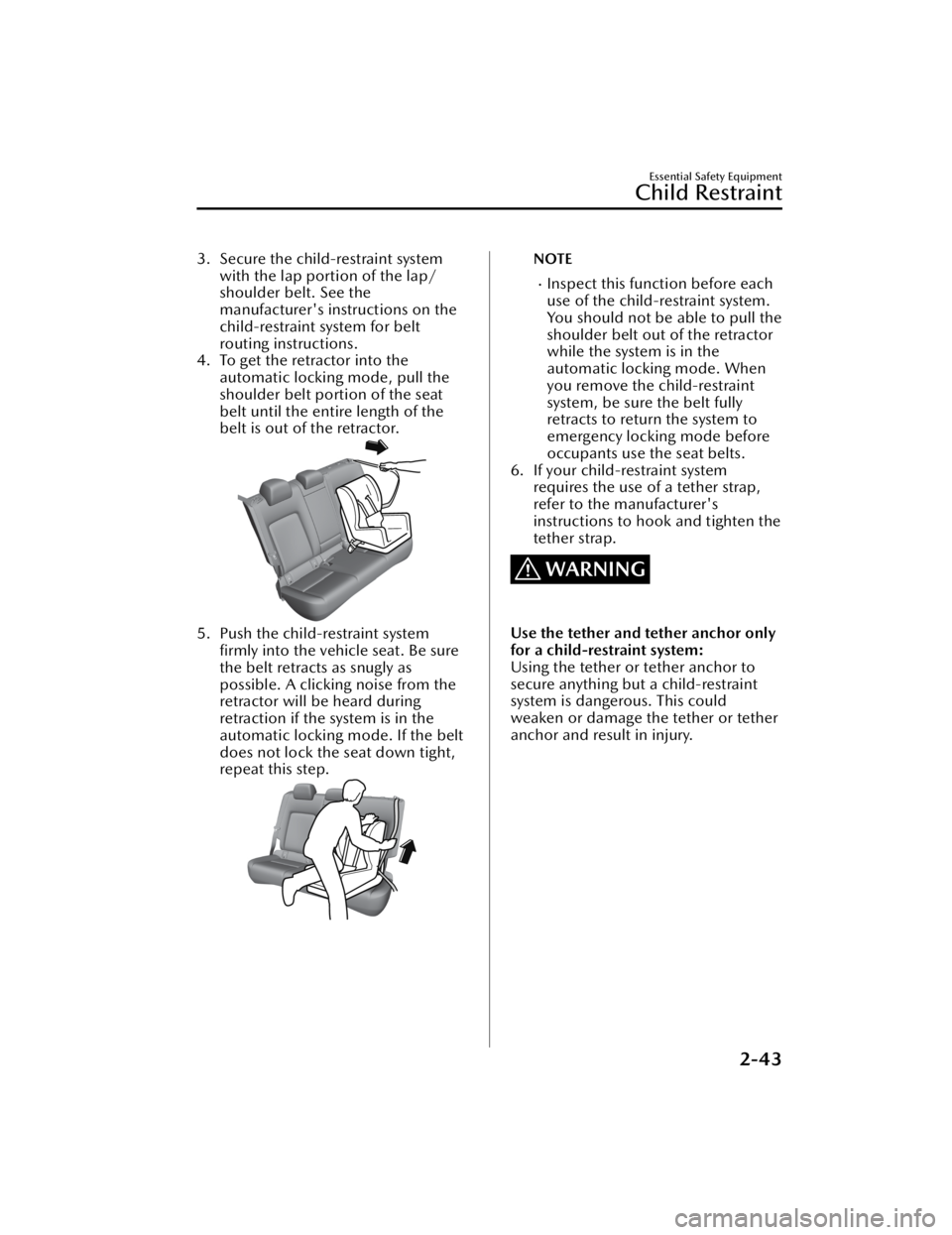
3. Secure the child-restraint systemwith the lap portion of the lap/
shoulder belt. See the
manufacturer's instructions on the
child-restraint system for belt
routing instructions.
4. To get the retractor into the automatic locking mode, pull the
shoulder belt portion of the seat
belt until the entire length of the
belt is out of the retractor.
5. Push the child-restraint systemfirmly into the vehicle seat. Be sure
the belt retracts as snugly as
possible. A clicking noise from the
retractor will be heard during
retraction if the system is in the
automatic locking mode. If the belt
does not lock the seat down tight,
repeat this step.
NOTE
Inspect this function before each
use of the child-restraint system.
You should not be able to pull the
shoulder belt out of the retractor
while the system is in the
automatic locking mode. When
you remove the child-restraint
system, be sure the belt fully
retracts to return the system to
emergency locking mode before
occupants use the seat belts.
6. If your child-restraint system requires the use of a tether strap,
refer to the manufacturer's
instructions to hook and tighten the
tether strap.
WARNING
Use the tether and tether anchor only
for a child-restraint system:
Using the tether or tether anchor to
secure anything but a child-restraint
system is dangerous. This could
weaken or damage the tether or tether
anchor and result in injury.
Essential Safety Equipment
Child Restraint
2-43
CX-50_8KB8-EA-22A_Edition2_new 2022-1-6 14:55:18
Page 62 of 583
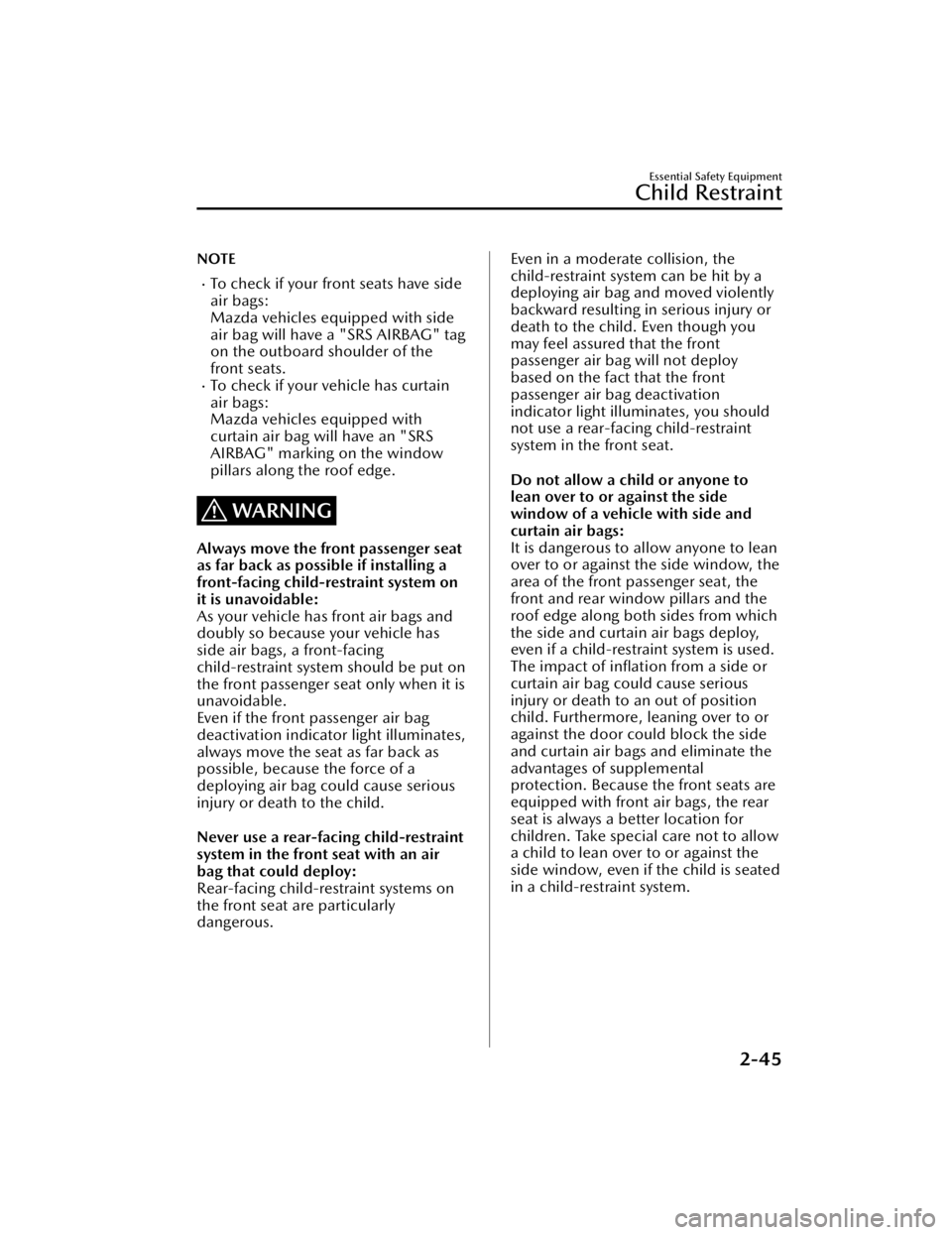
NOTE
To check if your front seats have side
air bags:
Mazda vehicles equipped with side
air bag will have a "SRS AIRBAG" tag
on the outboard shoulder of the
front seats.
To check if your vehicle has curtain
air bags:
Mazda vehicles equipped with
curtain air bag will have an "SRS
AIRBAG" marking on the window
pillars along the roof edge.
WARNING
Always move the front passenger seat
as far back as possible if installing a
front-facing child-restraint system on
it is unavoidable:
As your vehicle has front air bags and
doubly so because your vehicle has
side air bags, a front-facing
child-restraint system should be put on
the front passenger seat only when it is
unavoidable.
Even if the front passenger air bag
deactivation indicator light illuminates,
always move the seat as far back as
possible, because the force of a
deploying air bag could cause serious
injury or death to the child.
Never use a rear-facing child-restraint
system in the front seat with an air
bag that could deploy:
Rear-facing child-restraint systems on
the front seat are particularly
dangerous.
Even in a moderate collision, the
child-restraint system can be hit by a
deploying air bag and moved violently
backward resulting in serious injury or
death to the child. Even though you
may feel assured that the front
passenger air bag will not deploy
based on the fact that the front
passenger air bag deactivation
indicator light illuminates, you should
not use a rear-facing child-restraint
system in the front seat.
Do not allow a child or anyone to
lean over to or against the side
window of a vehicle with side and
curtain air bags:
It is dangerous to allow anyone to lean
over to or against the side window, the
area of the front passenger seat, the
front and rear window pillars and the
roof edge along both sides from which
the side and curtain air bags deploy,
even if a child-restraint system is used.
The impact of inflation from a side or
curtain air bag could cause serious
injury or death to an out of position
child. Furthermore, leaning over to or
against the door could block the side
and curtain air bags and eliminate the
advantages of supplemental
protection. Because the front seats are
equipped with fron t air bags, the rear
seat is always a better location for
children. Take special care not to allow
a child to lean over to or against the
side window, even if the child is seated
in a child-restraint system.
Essential Safety Equipment
Child Restraint
2-45
CX-50_8KB8-EA-22A_Edition2_new 2022-1-6 14:55:18
Page 63 of 583
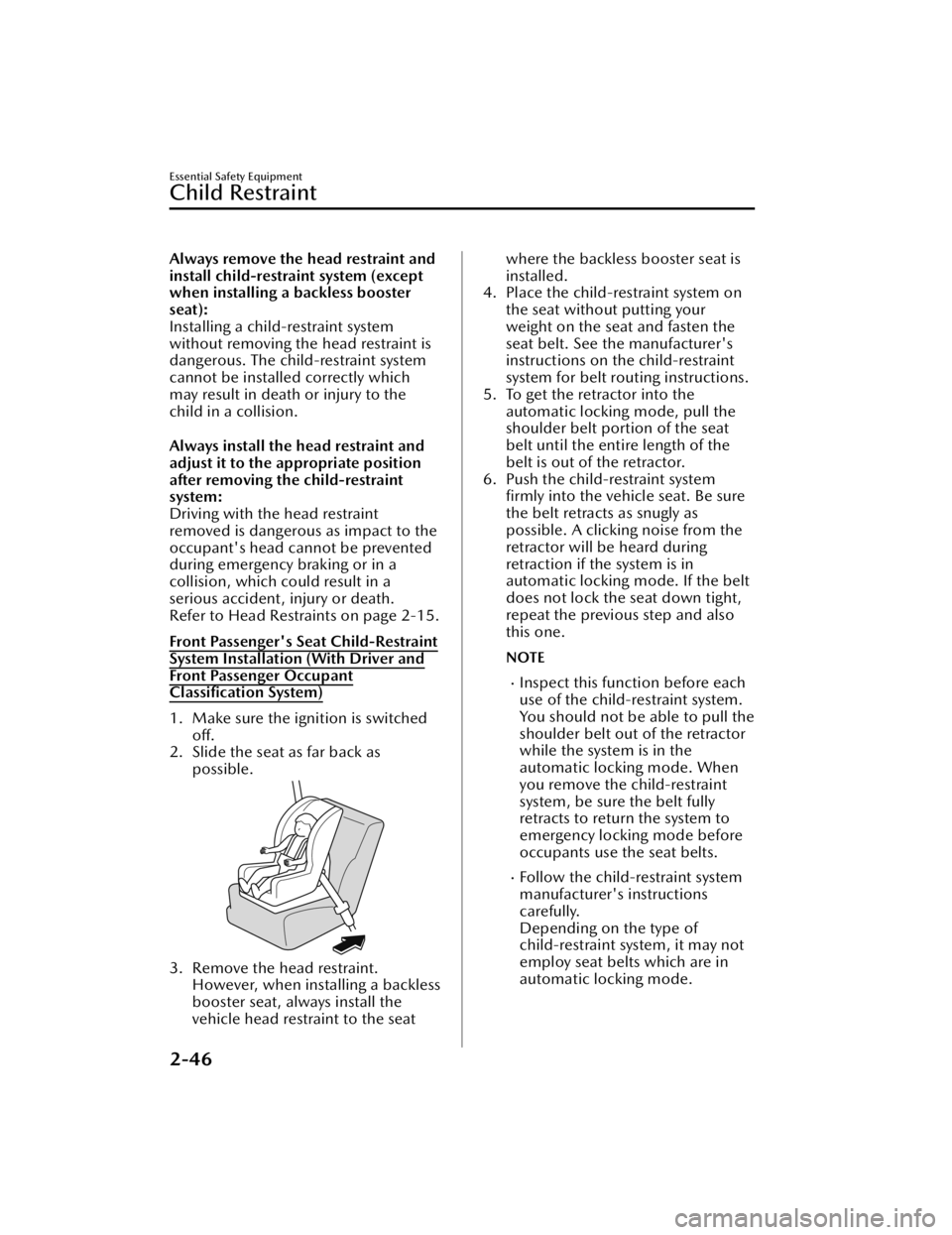
Always remove the head restraint and
install child-restraint system (except
when installing a backless booster
seat):
Installing a child-restraint system
without removing the head restraint is
dangerous. The child-restraint system
cannot be installed correctly which
may result in death or injury to the
child in a collision.
Always install the head restraint and
adjust it to the appropriate position
after removing the child-restraint
system:
Driving with the head restraint
removed is dangerous as impact to the
occupant's head cannot be prevented
during emergency braking or in a
collision, which could result in a
serious accident, injury or death.
Refer to Head Restraints on page 2-15.
Front Passenger's Seat Child-Restraint
System Installation (With Driver and
Front Passenger Occupant
Classification System)
1. Make sure the ignition is switchedoff.
2. Slide the seat as far back as
possible.
3. Remove the head restraint.However, when installing a backless
booster seat, always install the
vehicle head restraint to the seat
where the backless booster seat is
installed.
4. Place the child-restraint system on the seat without putting your
weight on the seat and fasten the
seat belt. See the manufacturer's
instructions on the child-restraint
system for belt routing instructions.
5. To get the retractor into the automatic locking mode, pull the
shoulder belt portion of the seat
belt until the entire length of the
belt is out of the retractor.
6. Push the child-restraint system firmly into the vehicle seat. Be sure
the belt retracts as snugly as
possible. A clicking noise from the
retractor will be heard during
retraction if the system is in
automatic locking mode. If the belt
does not lock the seat down tight,
repeat the previous step and also
this one.
NOTE
Inspect this function before each
use of the child-restraint system.
You should not be able to pull the
shoulder belt out of the retractor
while the system is in the
automatic locking mode. When
you remove the child-restraint
system, be sure the belt fully
retracts to return the system to
emergency locking mode before
occupants use the seat belts.
Follow the child-restraint system
manufacturer's instructions
carefully.
Depending on the type of
child-restraint system, it may not
employ seat belts which are in
automatic locking mode.
Essential Safety Equipment
Child Restraint
2-46
CX-50_8KB8-EA-22A_Edition2_new 2022-1-6 14:55:18
Page 66 of 583

child-restraint system and the front
seat.
Refer to Adjusting the Driver's Seat
on page 2-4.
Refer to Adjusting the Front
Passenger's Seat on page 2-12.
2. Make sure the seatback is securely latched by pushing it back until it is
fully locked.
3. Remove the cover of the child-restraint system's ISOFIX/
LATCH
*1 lower anchors to verify the
locations of the ISOFIX/LATCH*1
lower anchors.
1. Lower anchor
NOTE
The ISOFIX/LATCH*1 lower
anchors marking on the cover
indicates the position of the
ISOFIX/LATCH
*1 lower anchors
for the attachment of a
child-restraint system.
Store the removed cover so that it
does not get lost.
4. Remove the head restraint. However, when installing a backless
booster seat, always install the
vehicle head restraint to the seat
where the backless booster seat is
installed.
Refer to Head Restraints on page
2-15.
5. Secure the child-restraint system
using BOTH ISOFIX/LATCH*1 lower
anchors, following the
child-restraint system
manufacturer's instruction. Pull on
the child-restraint to be sure both
anchors are engaged.
6. If your child-restraint system came equipped with a tether, that means
it is very important to properly
secure the tether for child safety.
Please carefully follow the
child-restraint system
manufacturer's instructions when
installing tethers.
*1ISOFIX (Mexico)/LATCH (ExceptMexico)
WARNING
Use the tether and tether anchor only
for a child-restraint system:
Using the tether or tether anchor to
secure anything but a child-restraint
system is dangerous. This could
weaken or damage the tether or tether
anchor and result in injury.
Essential Safety Equipment
Child Restraint
2-49
CX-50_8KB8-EA-22A_Edition2_new 2022-1-6 14:55:18
Page 71 of 583

Do not sit too close to the driver and
front passenger air bags:
Sitting too close to the driver and front
passenger air bag modules or placing
hands or feet on them is extremely
dangerous. The driver and front
passenger air bags inflate with great
force and speed. Serious injuries could
occur if someone is too close. The
driver should always hold onto only the
rim of the steering wheel. The front
seat passenger should keep both feet
on the floor. Front seat occupants
should adjust their seats as far back as
possible and always sit upright against
the seatbacks with seat belts worn
properly.
Sit in the center of the seat and wear
seat belts properly:
Sitting too close to the side air bag
modules or placing hands on them, or
sleeping up against the door or
hanging out the windows is extremely
dangerous. The side and curtain air
bags inflate with great force and speed
directly expanding along the door on
the side the car is hit. Serious injury
could occur if someone is sitting too
close to the door or leaning against a
window, or if rear seat occupants grab
the sides of the front seatbacks. Give
the side and curtain air bags room to
work by sitting in the center of the seat
while the vehicle is moving with seat
belts worn properly.
Do not attach objects on or around
the area where air bags deploy:Attaching objects to the air bags or
placing something in the area where
the air bags deploy is dangerous. In an
accident, an object could interfere with
air bag inflation and injure the
occupants. Furthermore, the bag could
be damaged causing gases to release.
Always keep the deployment area of
the air bag modules free of any
obstructions.
For example, you should not do any of
the following as it may interfere with
air bag deployment.
Do not put a covering on or lean
anything against areas such as the
dashboard and lower portion of the
instrument panel that blocks the
passenger front air bag and knee air
bags.
Do not use seat covers on the front
seats and rear seats equipped with
in-seat side air bags.
Do not hang any backpacks, bags or
pouches that cover the sides of the
seats that block the side air bags.
Do not place any objects on the
assist grips. Only hang clothes
directly on the coat hooks.
Do not touch the components of the
supplemental restraint system after
the air bags have inflated:
Touching the components of the
supplemental restraint system after the
air bags have inflated is dangerous.
Immediately after inflation, they are
very hot. You could get burned.
Essential Safety Equipment
SRS Air Bags
2-54
CX-50_8KB8-EA-22A_Edition2_new 2022-1-6 14:55:18